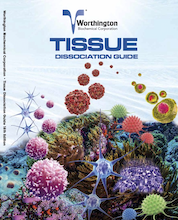For our international customers, please be advised that orders cannot be placed through our website by customers in countries with International Distributor representation.
Worthington Tissue Dissociation Guide
Introduction
Tissue dissociation/primary cell isolation and cell harvesting are principal applications for enzymes in tissue culture research and cell biology studies. Despite the widespread use of enzymes for these applications over the years, their mechanisms of action in dissociation and harvesting are not well understood. As a result, the choice of one technique over another is often arbitrary and based more on past experience than on an understanding of why the method works and what modifications could lead to even better results.
The goal of a cell isolation procedure is to maximize the yield of functionally viable, dissociated cells. There are many parameters which may affect the outcome of any particular procedure including but not limited to:
1. Type of tissue
2. Species of origin
3. Age of the animal
4. Genetic modification(s) (knockouts, etc.)
5. Dissociation medium used
6. Enzyme(s) used
7. Impurities in any crude enzyme preparation used
8. Concentration(s) of enzyme(s) used
9. Temperature
10. Incubation times
The first four items generally are not a matter of choice. To achieve suitable results the other variable conditions are best defined empirically.
Researchers searching the scientific literature for information on the ideal enzymes and optimal conditions for tissue dissociation are often confronted with conflicting data. Much of the variation stems from the complex and dynamic nature of the extracellular matrix and from the historical use of relatively crude, undefined enzyme preparations for cell isolation applications. Also, the extracellular matrix is composed of a wide variety of proteins, glycoproteins, lipids and glycolipids, all of which can differ in abundance from species to species, tissue to tissue and with developmental age. Commonly used crude enzyme preparations such as Pronase, NF 1:250 and collagenase contain several proteases in variable concentrations, as well as a variety of polysaccharidases, nucleases and lipases.
This guide summarizes our knowledge of how these enzymes accomplish the "routine" operations of tissue dissociation and cell harvesting, describes standard lab procedures, offers a logical experimental approach for establishing a cell isolation protocol, and lists many tissue specific references.
Tissue Tables
The Worthington Tissue Tables provide references useful to researchers interested in tissue dissociation and cell harvesting procedures. The references are organized by Tissue and Species type and linked to PubMed citations. The Cell type, Enzymes, and Medium for each reference is provided.
To search by specific criteria, use the Tissue References Search Tool.
